I was recently working on a deep learning model in Keras and it gave me very perplexing results. The model is capable of mastering the training data over time, but it consistently gets worse results on the validation data.
I know that if the validation accuracy goes up for a while and then starts to decrease that you are over-fitting to the training data, but in this case, the validation accuracy only ever decreases. I am really confused why this happens. Does anyone have any intuition as to what could cause this to happen? Or any suggestions on things to test to potentially fix it?
Edit to add more info and code
Ok. So I am making a model that is trying to do some basic stock predictions. By looking at the open, high, low, close, and volume of the last 40 days, the model tries to predict whether or not the price will go up two average true ranges without going down one average true range. As input, I took CSVs from Yahoo Finance that include this information for the last 30 years for all of the stocks in the Dow Jones Industrial Average. The model trains on 70% of the stocks and validates on the other 20%. This leads to about 150,000 training samples. I am currently using a 1d Convolutional Neural Network, but I have also tried other smaller models (logistic regression and small Feed Forward NN) and I always get the same either diverging train and validation loss or nothing learned at all because the model is too simple.
Here is the code:
import numpy as np
from sklearn import preprocessing
from sklearn.metrics import auc, roc_curve, roc_auc_score
from keras.layers import Input, Dense, Flatten, Conv1D, Activation, MaxPooling1D, Dropout, Concatenate
from keras.models import Model
from keras.callbacks import ModelCheckpoint, EarlyStopping, Callback
from keras import backend as K
import matplotlib.pyplot as plt
from random import seed, shuffle
from os import listdir
class roc_auc(Callback):
def on_train_begin(self, logs={}):
self.aucs = []
def on_train_end(self, logs={}):
return
def on_epoch_begin(self, epoch, logs={}):
return
def on_epoch_end(self, epoch, logs={}):
y_pred = self.model.predict(self.validation_data[0])
self.aucs.append(roc_auc_score(self.validation_data[1], y_pred))
if max(self.aucs) == self.aucs[-1]:
model.save_weights("weights.roc_auc.hdf5")
print(" - auc: %0.4f" % self.aucs[-1])
return
def on_batch_begin(self, batch, logs={}):
return
def on_batch_end(self, batch, logs={}):
return
rrr = 2
epochs = 200
batch_size = 64
days_input = 40
seed(42)
X_train = []
X_test = []
y_train = []
y_test = []
files = listdir("Stocks")
total_stocks = len(files)
shuffle(files)
for x, file in enumerate(files):
test = False
if (x+1.0)/total_stocks > 0.7:
test = True
if test:
print("Test -> Stocks/%s" % file)
else:
print("Train -> Stocks/%s" % file)
stock = np.loadtxt(open("Stocks/"+file, "r"), delimiter=",", skiprows=1, usecols = (1,2,3,5,6))
atr = []
last = None
for day in stock:
if last is None:
tr = abs(day[1] - day[2])
atr.append(tr)
else:
tr = max(day[1] - day[2], abs(last[3] - day[1]), abs(last[3] - day[2]))
atr.append((13*atr[-1]+tr)/14)
last = day.copy()
stock = np.insert(stock, 5, atr, axis=1)
for i in range(days_input,stock.shape[0]-1):
input = stock[i-days_input:i, 0:5].copy()
for j, day in enumerate(input):
input[j][1] = (day[1]-day[0])/day[0]
input[j][2] = (day[2]-day[0])/day[0]
input[j][3] = (day[3]-day[0])/day[0]
input[:,0] = input[:,0] / np.linalg.norm(input[:,0])
input[:,1] = input[:,1] / np.linalg.norm(input[:,1])
input[:,2] = input[:,2] / np.linalg.norm(input[:,2])
input[:,3] = input[:,3] / np.linalg.norm(input[:,3])
input[:,4] = input[:,4] / np.linalg.norm(input[:,4])
preprocessing.scale(input, copy=False)
output = -1
buy = stock[i][1]
stoploss = buy - stock[i][5]
target = buy + rrr*stock[i][5]
for j in range(i+1, stock.shape[0]):
if stock[j][0] < stoploss or stock[j][2] < stoploss:
output = 0
break
elif stock[j][1] > target:
output = 1
break
if output != -1:
if test:
X_test.append(input)
y_test.append(output)
else:
X_train.append(input)
y_train.append(output)
shape = list(X_train[0].shape)
shape[:0] = [len(X_train)]
X_train = np.concatenate(X_train).reshape(shape)
y_train = np.array(y_train)
shape = list(X_test[0].shape)
shape[:0] = [len(X_test)]
X_test = np.concatenate(X_test).reshape(shape)
y_test = np.array(y_test)
print("Train class split is %0.2f" % (100*np.average(y_train)))
print("Test class split is %0.2f" % (100*np.average(y_test)))
inputs = Input(shape=(days_input,5))
x = Conv1D(32, 5, padding='same')(inputs)
x = Activation('relu')(x)
x = MaxPooling1D()(x)
x = Conv1D(64, 5, padding='same')(x)
x = Activation('relu')(x)
x = MaxPooling1D()(x)
x = Conv1D(128, 5, padding='same')(x)
x = Activation('relu')(x)
x = MaxPooling1D()(x)
x = Flatten()(x)
x = Dense(128, activation="relu")(x)
x = Dense(64, activation="relu")(x)
output = Dense(1, activation="sigmoid")(x)
model = Model(inputs=inputs,outputs=output)
model.compile(optimizer='adam',
loss='binary_crossentropy',
metrics=['accuracy'])
filepath="weights.best.hdf5"
checkpoint = ModelCheckpoint(filepath, monitor='val_acc', verbose=0, save_best_only=True, mode='max')
auc_hist = roc_auc()
callbacks_list = [checkpoint, auc_hist]
history = model.fit(X_train, y_train, validation_data=(X_test,y_test) , epochs=epochs, callbacks=callbacks_list, batch_size=batch_size, class_weight ='balanced').history
model_json = model.to_json()
with open("model.json", "w") as json_file:
json_file.write(model_json)
model.save_weights("weights.latest.hdf5")
model.load_weights("weights.roc_auc.hdf5")
plt.plot(history['acc'])
plt.plot(history['val_acc'])
plt.title('model accuracy')
plt.ylabel('accuracy')
plt.xlabel('epoch')
plt.legend(['train', 'test'], loc='upper left')
plt.show()
plt.plot(history['loss'])
plt.plot(history['val_loss'])
plt.title('model loss')
plt.ylabel('loss')
plt.xlabel('epoch')
plt.legend(['train', 'test'], loc='upper left')
plt.show()
plt.plot(auc_hist.aucs)
plt.title('model ROC AUC')
plt.ylabel('AUC')
plt.xlabel('epoch')
plt.show()
y_pred = model.predict(X_train)
fpr, tpr, _ = roc_curve(y_train, y_pred)
roc_auc = auc(fpr, tpr)
plt.subplot(1, 2, 1)
plt.plot(fpr, tpr, label='ROC curve (area = %0.2f)' % roc_auc)
plt.plot([0, 1], [0, 1], color='navy',linestyle='--')
plt.xlim([0.0, 1.0])
plt.ylim([0.0, 1.0])
plt.xlabel('False Positive Rate')
plt.ylabel('True Positive Rate')
plt.title('Train ROC')
plt.legend(loc="lower right")
y_pred = model.predict(X_test)
fpr, tpr, thresholds = roc_curve(y_test, y_pred)
roc_auc = auc(fpr, tpr)
plt.subplot(1, 2, 2)
plt.plot(fpr, tpr, label='ROC curve (area = %0.2f)' % roc_auc)
plt.plot([0, 1], [0, 1], color='navy',linestyle='--')
plt.xlim([0.0, 1.0])
plt.ylim([0.0, 1.0])
plt.xlabel('False Positive Rate')
plt.ylabel('True Positive Rate')
plt.title('Test ROC')
plt.legend(loc="lower right")
plt.show()
with open('roc.csv','w+') as file:
for i in range(len(thresholds)):
file.write("%f,%f,%f\n" % (fpr[i], tpr[i], thresholds[i]))
Results by 100 batches instead of by epoch
I listened to suggestions and made a few updates. The classes are now balanced 50% to 50% instead of 25% to 75%. Also, the validation data is randomly selected now instead of being a specific set of stocks. By graphing the loss and accuracy at a finer resolution(100 batches vs 1 epoch), the over-fitting can clearly be seen. The model does actually start to learn at the very beginning before it starts to diverge. I am surprised at how fast it starts to over-fit, but now that I can see the issue hopefully I can debug it.



